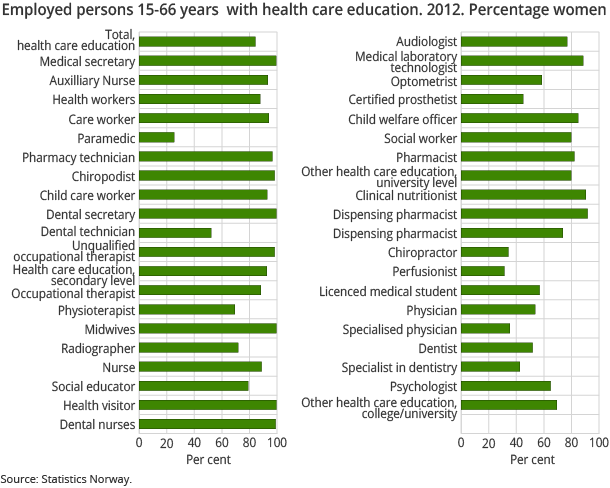Content
Published:
This is an archived release.
Increase in foreign health care personnel
The number of employed persons with a health care education increased by 2.4 per cent between the 4th quarter of 2011 and the 4th quarter of 2012. Employed immigrants and foreign citizens on short-term stays in Norway increased by 9 per cent.
| 2012 | 2011 - 2012 | 2011 | ||
|---|---|---|---|---|
| Total | Share | Per cent | Total | |
| The number of persons 15-66 years with health care education in 2012 was reduced by 5 900 persons in the autumn of 2013. Due to a registration error in one of the source registries, these persons with a Norwegian health care personnel authorization were incorrectly included, even though they were neither employed or resided in Norway in 2012. | ||||
| Persons with a health care education | 417 970 | 100.0 | 2.5 | 407 770 |
| Men | 62 913 | 15.1 | 3.0 | 61 070 |
| Women | 355 057 | 84.9 | 2.4 | 346 700 |
| Employed persons with a health care education | 361 455 | 100.0 | 2.3 | 353 271 |
| Men | 56 867 | 15.7 | 2.8 | 55 342 |
| Women | 304 588 | 84.3 | 2.2 | 297 929 |
| Employed persons with a health care education in health and social services | 286 696 | 79.3 | 2.0 | 281 090 |
A total of 30 700 persons with a health care education working within the health care industry were immigrants or foreign citizens on short-term stays in 2012. A total of 9 600 of these immigrants were nurses and 4 800 were physicians. About 38 per cent of 30 700 persons with a foreign background were of African, Asian and South American origin.
Biggest increase in health worker educated persons
Employees with a health care education or a licence to work in health care increased by 2 700. The new health worker education replaces auxiliary nurse and care worker qualifications. Employed auxiliary nurses and care workers decreased by 3 500 persons. All three groups combined had a net decrease of almost 800 employed persons.
Women make up 84 per cent of health and care personnel
Only six health care educations in these statistics consist of more men than women. This applies to specialists in dentistry, specialised physicians, ambulance workers, chiropractors, perfusionists and orthopaedic engineers. Among medical secretary, dental secretary, dental nurse, health visitor and midwife educations, women totalled over 99 per cent.
Health care workers work primarily in the public sector
Fifty-one per cent of all persons with a health care education work within the municipal sector. Thirty-one per cent of all persons with such an education work in the governmental sector, primarily in health enterprises. Eighty-two per cent of all employees between 15-74 years with a health care education work in the public sector.
Working hours and number of jobs
Average work hours per employed person with a health care education who work in the health care industry are 31.4 in the 4th quarter of 2012; approximately unchanged in the last three years. Many people have more than one employment relationship. Nearly 22 per cent of specialised physicians have multiple jobs, compared to 9.6 per cent of all health care educated persons who work in health care.
New information about educationOpen and readClose
Data used in statistics on education level in the Norwegian population has been updated with survey data from the autumn of 2011. This survey concerns immigrants who have completed their education abroad before moving to Norway. As a result, the number of employed persons with missing information on education is now significantly lower compared to publications in previous years. This mainly applies to persons without a health care education, since people with a health care education need a licence to work in health care.
Contact
-
Arbeidsmarked og lønn
E-mail: arbeidsmarked@ssb.no
-
Fredrik Steinrem Edelmann
E-mail: fredrik.edelmann@ssb.no
tel.: (+47) 40 90 24 60
-
Sophie Sæternes
E-mail: sophie.saeternes@ssb.no
tel.: (+47) 98 67 14 26
-
Stine Bakke
E-mail: stine.bakke@ssb.no
tel.: (+47) 91 52 62 51

